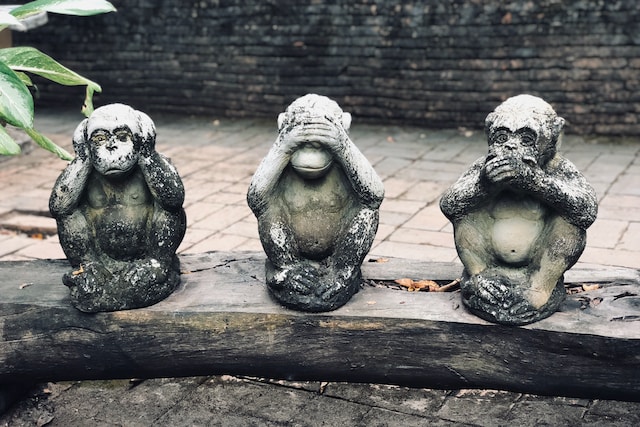A saying is a general statement expressing an idea or opinion, while a proverb is a short, traditional saying that expresses a practical truth or piece of wisdom. Proverbs are typically more specific and culturally rooted than sayings.
What is a saying?
(Photo by Nick Fewings on Unsplash )

A saying is a short and commonly used phrase or expression that conveys a particular idea or message. Sayings are usually based on experience or observation, and they may be used to provide advice, encouragement, or caution. They can be humorous, witty, or serious, and they often become a part of a culture’s oral tradition.
Sayings can be used to illustrate a point, provide clarity, or to convey a moral lesson. They may also serve as a way of communicating a shared cultural heritage, as well as providing insight into the attitudes and values of a particular group or society. Some sayings are so well-known that they have become part of everyday language, such as “time flies when you’re having fun,” “actions speak louder than words,” or “honesty is the best policy.”
Overall, sayings are a valuable aspect of language that can help to communicate complex ideas and beliefs in a concise and memorable way.
What is a proverb?
(Photo by Joao Tzanno on Unsplash )

A proverb is a short, pithy saying that expresses a traditionally held truth or piece of advice. Proverbs are often metaphorical and use simple, concrete images to teach a moral lesson. For example: “A stitch in time saves nine.” This proverb suggests that it’s better to take care of a problem immediately, rather than wait and have to deal with a bigger mess later on.
Proverbs can be found in nearly every culture and language, and new proverbs are created all the time. In English, there are hundreds of well-known proverbs, such as “actions speak louder than words” and “you can’t judge a book by its cover.” Many proverbs are based on historical events or ancient wisdom. Others were made up more recently, but have been repeated so often that they’ve become accepted as truth.
Proverbs usually offer guidance about how to live your life, but they don’t always give specific instructions about what to do in any given situation. That’s because proverbs are meant to be general principles that you can apply to many different situations. They offer a way of looking at the world that can help you make better decisions, even when you don’t have all the facts.
Examples of sayings
- “A stitch in time saves nine.”
- “An apple a day keeps the doctor away.”
- “A penny saved is a penny earned.”
- “Absence makes the heart grow fonder.”
- “All good things must come to an end.”
- “Birds of a feather flock together.”
Examples of proverbs
- A stitch in time saves nine
- An apple a day keeps the doctor away
- A penny saved is a penny earned
- All’s fair in love and war
- Honesty is the best policy
Sayings Vs. Proverbs – Key differences
Sayings and proverbs are both forms of idiomatic expressions, but they have some key differences. Here are a few differences between the two:
Length: Sayings are generally shorter than proverbs, often just a few words or a brief phrase, while proverbs are usually a complete sentence or two.
Origin: Sayings can come from any source, while proverbs are usually derived from cultural or religious traditions.
Purpose: Sayings are often used to express a general idea or opinion, while proverbs are typically used to convey a specific message or a practical truth.
Generality: Sayings are often more general and less culturally specific than proverbs, which tend to be more culturally rooted.
Age: Proverbs are usually much older than sayings, often having been passed down for generations.
Structure: Proverbs often have a clear structure, with two parts that contrast or balance each other, while sayings may not have a structured form.
While both sayings and proverbs are valuable forms of expression, proverbs tend to be more structured and culturally rooted, while sayings are more general and can come from any source.
How do you differentiate sayings from proverbs?
There are a few key things to look for when trying to determine whether a phrase is a saying or a proverb. First, sayings are often more concise than proverbs and they typically don’t contain as much moral or ethical advice. They also tend to be more specific in their application, while proverbs are more general. Another key difference is that sayings are often used to make a point or offer commentary on a particular situation, while proverbs are meant to be taken more literally as wise counsel.
What are the characteristics of proverbs and sayings?
Proverbs and sayings are both types of idiomatic expressions that have certain characteristics in common. Here are some of the key characteristics of proverbs and sayings:
Conciseness: Both proverbs and sayings are usually brief and to the point, often consisting of just a few words or a short phrase.
Figurative language: Proverbs and sayings often use metaphor, simile, and other types of figurative language to convey their meaning.
Cultural context: Proverbs and sayings are often rooted in a particular culture or tradition and reflect the values, beliefs, and experiences of that culture.
Practical wisdom: Proverbs and sayings are often used to convey practical wisdom and common sense advice about how to live one’s life.
Repetition: Proverbs and sayings are often repeated over time and become a part of a culture’s oral tradition.
Authorship: While many proverbs and sayings are anonymous, some are attributed to a particular author or cultural figure.
Memorable: Proverbs and sayings are often memorable and easy to remember due to their conciseness and use of figurative language.
Proverbs and sayings are valuable forms of expression that can provide insight into a culture’s beliefs and values, as well as offer practical wisdom about how to live a good life.
What are the two types of proverbs?
Proverbs can be classified into two main types: traditional proverbs and literary proverbs.
Traditional proverbs are passed down orally from one generation to another and are part of a culture’s oral tradition. These proverbs are often anonymous and have been in use for centuries. Traditional proverbs are usually concise and pithy, and they convey practical wisdom about life.
Literary proverbs are written by authors and are found in literature, such as novels, poems, and plays. Unlike traditional proverbs, literary proverbs are often attributed to a particular author and may be used to convey a specific message or theme within a work of literature. Literary proverbs can also be concise and pithy, but they are more likely to be longer and more complex than traditional proverbs.
Both types of proverbs are valuable expressions of wisdom and have been used to convey practical advice and moral lessons for generations.
Featured Image By – Alexandra Fuller on Unsplash








